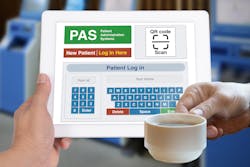At the end of July, NYC Health + Hospitals/Bellevue announced they’ve made amazing strides toward improving the patient experience and expanding patient access to primary care services. By partnering with NYC Health + Hospitals’ Manhattan call center, developing scripts that emphasize continuity between patients and primary care providers (PCP), and transitioning to an electronic health system, Bellevue was able to cut wait times down from 52 days to 14. Now, patients are able to see the same primary care physician 87.1 percent of the time.
NYC Health + Hospitals/Bellevue made major advancements to their overall infrastructure to achieve their lofty goals of improving the patient experience and reducing patient wait times. Could you see the same transformation on a smaller scale? Formstack offers several great ways to do just that.
Here’s how you can use Formstack’s online forms to enhance scheduling workflows, reduce patient wait times, and improve patient satisfaction.
1. Transform the patient registration process.
Physicians spend 49% of their time doing paperwork, even with an EHR system in place. Every second of time is valuable in your office. Time spent sorting and filing data and manually updating EHRs and CRMs is time that could be spent seeing patients and, ultimately, reducing patient wait times. If you’re frustrated with how you’re currently registering patients, it’s time for an upgrade.
Online forms can completely transform your patient registration process. Formstack forms eliminate the need for paper by integrating with your current workflows. With online forms, you can:
- Gather the information you need from your patients before they even set foot in your office.
- Automatically route patient information to the necessary departments.
- Build a quality patient care plan and schedule follow-up appointments.
Formstack makes it really easy to start updating your patient registration process and scheduling workflows. Try any of our healthcare form templates to get started.
Related: How to Transform the Patient Experience
2. Speed up your referral process.
If patient’s need care from another doctor within your hospital or provider system, scheduling their next appointment can be a hassle. Take a page out of Indiana Health Group’s playbook. They’re modernizing their scheduling workflows by adding QR codes to their forms. Now, their referral process can be conducted at the bedside and only takes about 30-45 seconds.
“I think patients like the experience of filling out the forms online. In our case, I think it often makes for a more comfortable experience since patients can be sharing some things that might be a little uncomfortable to talk about or that they might feel some degree of guilt or embarrassment about.” Chris Bojrab Indiana Health Group
3. Integrate your healthcare forms with WebHooks
Part of the success of the NYC Health + Hospitals/Bellevue initiative is due to the successful creation of buy-in across leadership and physicians for these changes. Change is difficult for most organizations, but the Bellevue initiative was especially daunting. To ensure your organizational transformation is widely accepted, try to integrate new workflows with the tools your staff already use.
Formstack makes it easy to build online healthcare forms and connect them to your EHR via WebHooks. This features cuts down on cumbersome, error-prone paper processes. By creating an efficient online process that uses WebHooks, you can automatically and seamlessly pass ePHI from your forms to your EHR. Now, it’s easier than ever to track patients and keep accurate, secure records.
Learn More: How to create a WebHook connection in Formstack
4. Add Formstack Approvals and Workflows to your process
When you’re writing prescriptions or establishing a shared care plan for your patients, it’s critical that every provider involved in patient care has the opportunity to review and approve. With Formstack, you get access to a suite of features that allow you to streamline the day-to-day tasks of your back office.
With Formstack Workflows, you can easily keep staff informed and in the loop on tasks or requirements regarding specific patients. Care plans, referrals, and suggested prescriptions can be approved or denied directly from everyone’s email.
BONUS: HIPAA compliance
Of course, Formstack is HIPAA compliant, so you can safely use your online forms to collect and store patient health data. Formstack HIPAA accounts include a set of security features and settings designed to uphold HIPAA compliance standards. Some of these features include the recommended use of SMTP email servers, access to HIPAA-approved integrations and WebHooks, Account User permissions, and Data Encryption! Check out our HIPAA account guide to learn more about these features. If you’re looking for a compliant way to capture PHI, reduce patient wait times, and increase patient satisfaction, Formstack is the platform for you.
If you’re ready to add workflow automation to your healthcare organization, you can get started with a 14-day free trial.


